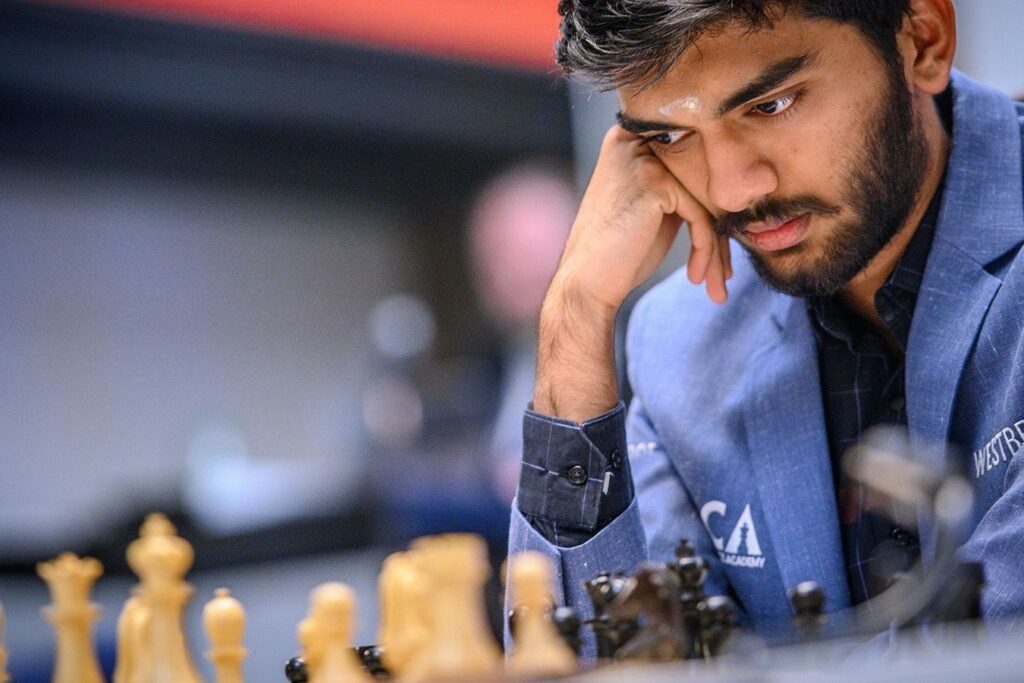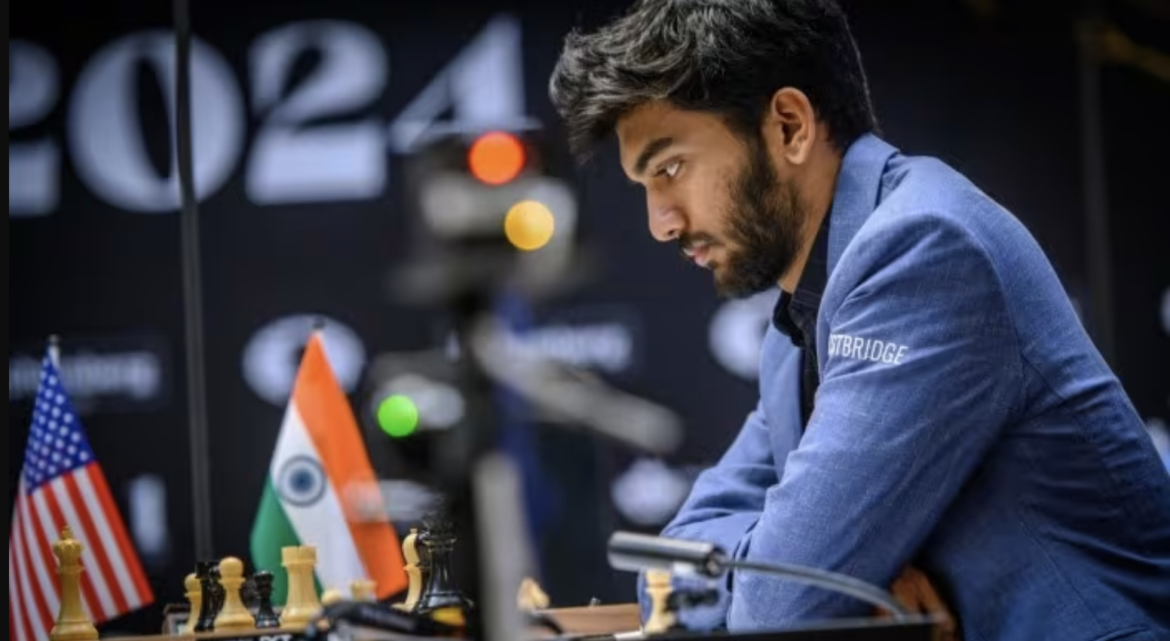At Chessboard Vault, we often explore the evolution of chess through the stories of its greatest players like Garry Kasparov, and Dommaraju Gukesh represents one of the most exciting narratives in recent years. At just 17, Gukesh has not only secured his spot in history but also brought a wave of enthusiasm to the global chess scene. His victory at the 2024 Candidates Tournament, where he outplayed legends like Hikaru Nakamura, Fabiano Caruana, and Ian Nepomniachtchi, has set him up for a highly anticipated World Chess Championship match against Ding Liren.
This article delves into how Gukesh became the youngest-ever World Chess Championship challenger, a milestone that has reignited the golden age of chess in India. By analyzing his unique tactical approach, mental resilience, and steady rise through the ranks, we aim to showcase why Gukesh is a force to be reckoned with. We’ll also explore the broader impact of his success on Indian chess and the global chess community at large.

We believe Gukesh’s journey deserves special attention because his meteoric rise reflects the changing dynamics of the chess world. From becoming a grandmaster at 12 to now challenging the world champion at 17, Gukesh’s story is one of inspiration for young players everywhere. His fearless style, combined with his ability to compete with the game’s elite, sets him apart from many young prodigies.
Here at Chessboard Vault, we aim to explore these critical moments in depth. Is Gukesh the next Magnus Carlsen, or will his youth be a disadvantage when he faces Ding Liren? Will his fearless, aggressive play lead him to the world title?
1. The Road to Success: Gukesh’s Early Career
At a time when most teenagers are balancing school and hobbies, Gukesh Dommaraju was mastering a craft that would propel him to the pinnacle of the chess world. Born in Chennai, India, Gukesh demonstrated a rare talent for chess from an early age, achieving the coveted title of Grandmaster (GM) at just 12 years and 7 months. This made him the second-youngest GM in history at the time, a feat that marked the beginning of a remarkable career trajectory.
From those early triumphs, Gukesh’s journey was defined by a blend of ambition and relentless work ethic. Unlike many prodigies who plateau after early successes, Gukesh’s rise has been consistent. He showcased a knack for beating seasoned professionals in various prestigious tournaments. With a sharp tactical style and a fearless approach to the board, Gukesh quickly gained a reputation for his attacking prowess and ability to handle complex positions under pressure.
His ascent to the upper echelons of chess was highlighted by his consistent performances across major tournaments, eventually breaking into the top 10 of the FIDE rankings. His participation in the 2022 Chess Olympiad was a key turning point, where he was instrumental in India’s strong team showing, leading to global recognition. By the time he entered the 2024 Candidates Tournament, Gukesh was no longer seen as just a prodigy but a serious contender on the world stage. His performances in this tournament, where he defeated some of the biggest names in chess like Praggnanandhaa and Alireza Firouzja, cemented his place as one of the elite players.
Despite the pressure and expectations, Gukesh has remained grounded, crediting his parents, particularly his father, a medical professional, for fostering an environment that emphasized patience and learning over immediate results. With his eyes now set on challenging the reigning World Champion, Ding Liren, Gukesh’s story is not only one of early success but also of a continuous drive to improve. As he steps onto the world’s biggest chess stage, his career serves as a reminder that even the youngest talents can rise to meet the game’s toughest challenges.
2. Best Game Showcase: Gukesh Dommaraju vs. Alireza Firouzja (2024 Candidates Tournament)
Opening Phase (1.e4 e5 to 10.Bb3 a5):
Gukesh opens with 1.e4, entering a Ruy Lopez (Spanish Game), one of the most classical and rich openings in chess history. Both players follow standard theory until 4.d3, which indicates a quieter and more strategic line compared to the sharper open lines. Firouzja’s response with 4…Bc5 and 5…Nd4 demonstrates his intention to pressure early. Gukesh handles this calmly, exchanging on d4 and building a solid setup with Nd2, Nc4, and castling, gaining flexibility for his pieces.
Middlegame Tactics (11.Nc4 to 25.c4 Nh5):
In the middlegame, Firouzja pushes for activity with 11…Ba7, positioning his pieces aggressively, but Gukesh remains steady, bringing his queen to f3 and exchanging pawns in the center with exd5. The key move here is 17.h3, a preparatory move by Gukesh that gives his king some air while holding the structure solid.
Firouzja tries to break through with 18…e4, but Gukesh handles it well, maintaining control of the center. At 25.c4, Gukesh opens up the position for his bishops, while Firouzja responds with 25…Nh5, aiming to create counterplay by targeting weak squares around Gukesh’s king.
Endgame Precision (26.g3 to 44.Kf2):
The game becomes tense as both sides push for activity. Firouzja’s Re6 and Qc5 show his intent to pile pressure on Gukesh’s position, but Gukesh maintains the balance. A crucial moment arrives with 33.Ne3, where Gukesh consolidates his kingside while neutralizing Firouzja’s threats. The rook maneuvers in the center (Rd2, Rd5) give Gukesh complete control over the d-file, forcing Firouzja into defensive measures.
The game transitions into an endgame where both players have active rooks, but Gukesh has the initiative due to his better pawn structure and the passive positioning of Firouzja’s knights.
Decisive Moments (44.Kf2 to 63.Kg3):
Firouzja tries to stir up counterplay with g5 and Nf6, but Gukesh remains composed, slowly improving his position. After gxf4 and Rg6, Gukesh targets weaknesses in Firouzja’s camp with Qg5 and Qf2, centralizing his pieces and preparing a decisive attack. Firouzja’s knight lacks sufficient coordination with his rooks, and Gukesh capitalizes on this imbalance.
By move 63, Gukesh has a decisive advantage, with his passed pawns and active rook completely overwhelming Firouzja’s remaining pieces. Firouzja is forced to resign after 63.Kg3, with no way to stop Gukesh’s pawns from promoting.
Key Takeaways on Gukesh’s Game:
- Gukesh’s Calm Under Pressure: Firouzja is known for his aggressive style, but Gukesh remained composed throughout the game, neutralizing threats with precise moves.
- Superior Endgame Technique: Gukesh demonstrated excellent endgame technique, converting a slight edge into a winning position by gradually improving his pieces and creating passed pawns.
- Strategic Flexibility: Throughout the game, Gukesh showed flexibility in both attack and defense, transitioning smoothly from a solid opening to a dynamic middlegame and a dominant endgame.
3. My Opinion on Gukesh Dommaraju
Gukesh Dommaraju has proven, time and time again, that he is one of the brightest young talents in the chess world. At just 17, his victory in the 2024 Candidates Tournament has not only earned him a spot in the upcoming World Championship match but also positioned him as a serious contender for the world title. Few players have ascended the ranks as quickly and decisively as Gukesh, and his potential to become the next World Chess Champion is becoming increasingly evident.
One of Gukesh’s strongest attributes is his mental resilience, especially under pressure. This was on full display during the Candidates Tournament, where he faced off against some of the strongest players in the world, including Fabiano Caruana, Ian Nepomniachtchi, and Alireza Firouzja. In high-stakes games, like his decisive draw against Hikaru Nakamura in the final round or his victory over Firouzja, Gukesh showed remarkable composure. This mental toughness, combined with his ability to recover after setbacks, as seen in his bounce-back win after a tough loss to Firouzja earlier in the tournament, is a hallmark of championship-caliber players
Tactically, Gukesh’s sharp attacking style is reminiscent of the greats. His ability to find creative solutions in complex positions, especially under time pressure, is a significant strength. This was particularly evident in his victory over Vidit Gujrathi, where Gukesh unleashed a series of tactical blows that overwhelmed his opponent. His precise calculation, aggressive play, and willingness to take risks are qualities that distinguish him from many of his peers. His game against Firouzja, where he gradually outmaneuvered one of the most aggressive young grandmasters, highlights his positional understanding and ability to convert small advantages into decisive victories
What makes Gukesh a formidable challenger for the world title is his well-roundedness. He is not only a brilliant tactician but also excels in the endgame, where his technique is solid and precise. His ability to shift between sharp, tactical play and methodical, strategic maneuvering makes him dangerous against any opponent. The best example of this was his calm play in the final rounds of the Candidates, where he avoided risks while holding his lead, showing maturity far beyond his years
At this point in his career, Gukesh possesses all the necessary tools to become World Chess Champion: a strong tactical foundation, deep positional understanding, mental resilience, and a fearless approach to the game. His rapid improvement, consistent performance, and wins against elite players suggest that he is more than capable of taking the next step. In my opinion, Gukesh Dommaraju could very well be the next name we see crowned as the world champion, continuing the legacy of great Indian players like Viswanathan Anand, and ushering in a new era of chess excellence.
4. Conclusion
As we look ahead, Gukesh Dommaraju stands out not just as a remarkable talent but as a symbol of the future of chess. What makes him unique is his blend of youthful energy and a maturity far beyond his years, qualities that have allowed him to rise from a prodigious talent to a serious contender for the world championship. At only 17, Gukesh’s journey is just beginning, yet he has already managed to outshine seasoned grandmasters and etch his name among chess’s elite.
Moreover, Gukesh is part of a new generation of players who embrace technology, data, and rigorous self-analysis. His commitment to training with AI tools, learning from engines like Stockfish, and embracing innovative study methods gives him an edge over many of his contemporaries. This ability to blend traditional chess wisdom with cutting-edge tools sets him up perfectly for a future where preparation and adaptability are paramount.
Another key factor in Gukesh’s rise is his environment. India, with its rich chess culture and the legacy of Viswanathan Anand, provides a fertile ground for nurturing talent.
Gukesh’s success has already inspired a new wave of young players in India, making him not just a player to watch, but a role model. His rise represents more than individual achievement—it reflects the growing influence of Indian chess on the global stage.
What truly separates Gukesh, however, is his fearless approach. Whether playing against elite grandmasters or handling the pressure of critical matches, he shows no hesitation in embracing risks and seeking dynamic positions. This fearless spirit is what makes Gukesh exciting to watch, and it’s what may one day lead him to the title of World Chess Champion.
In a world where the chess elite are continually pushing the boundaries of the game, Gukesh is poised to lead the charge. His blend of tactical brilliance, strategic depth, and psychological resilience positions him not only as a future champion but also as someone who will help shape the game in the years to come. It’s clear that Gukesh’s story is only just beginning, and the chess world will be eagerly watching as he continues to climb towards the summit.

